Cloud Based Solutions and Information Systems
VerifiedAdded on 2023/06/11
|11
|2590
|301
AI Summary
This paper analyses the relationships between cloud computing and information systems. It highlights notable IS vendors together with their affiliated features. The strengths and weaknesses of cloud solutions are discussed, and the SDLC approach is reviewed.
Contribute Materials
Your contribution can guide someone’s learning journey. Share your
documents today.
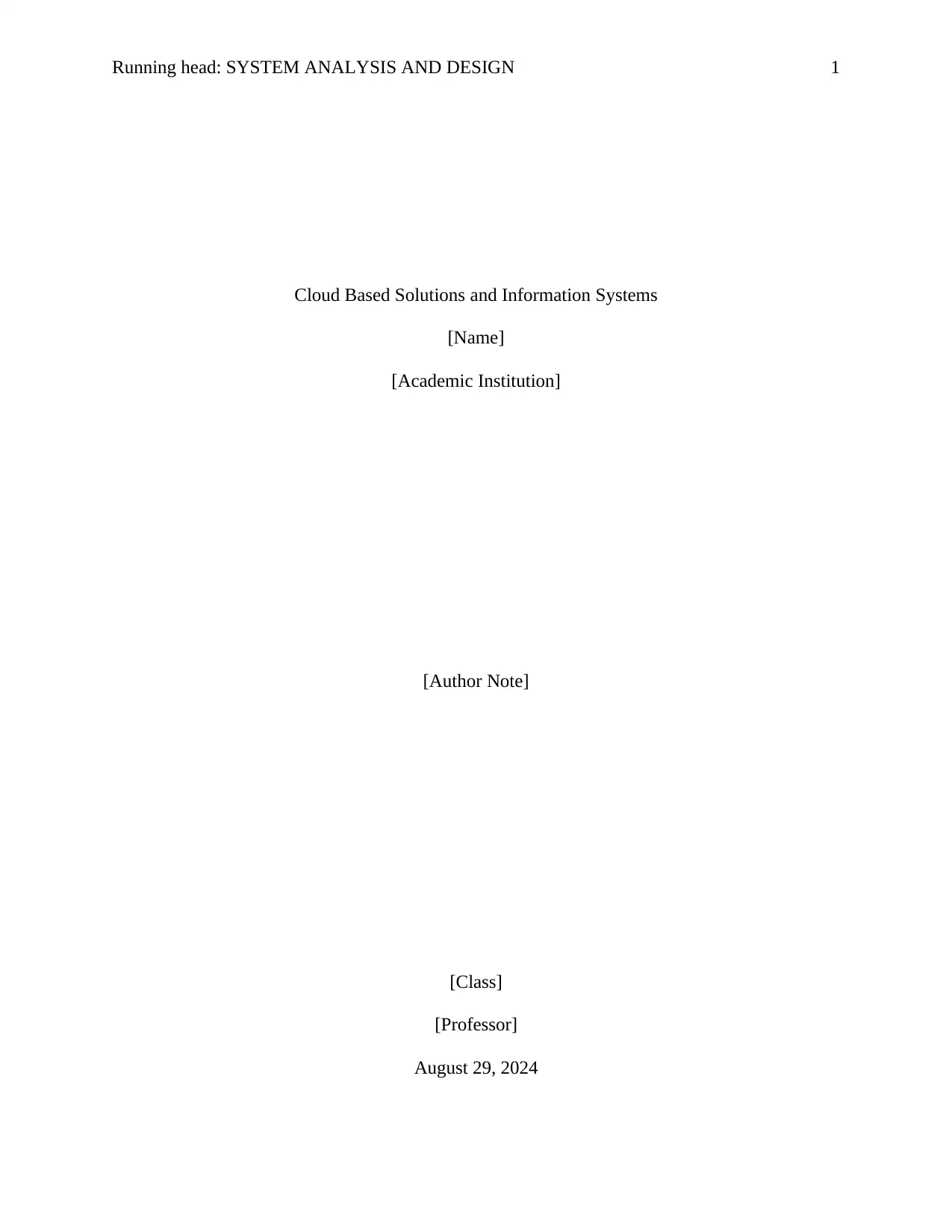
Running head: SYSTEM ANALYSIS AND DESIGN 1
Cloud Based Solutions and Information Systems
[Name]
[Academic Institution]
[Author Note]
[Class]
[Professor]
August 29, 2024
Cloud Based Solutions and Information Systems
[Name]
[Academic Institution]
[Author Note]
[Class]
[Professor]
August 29, 2024
Secure Best Marks with AI Grader
Need help grading? Try our AI Grader for instant feedback on your assignments.
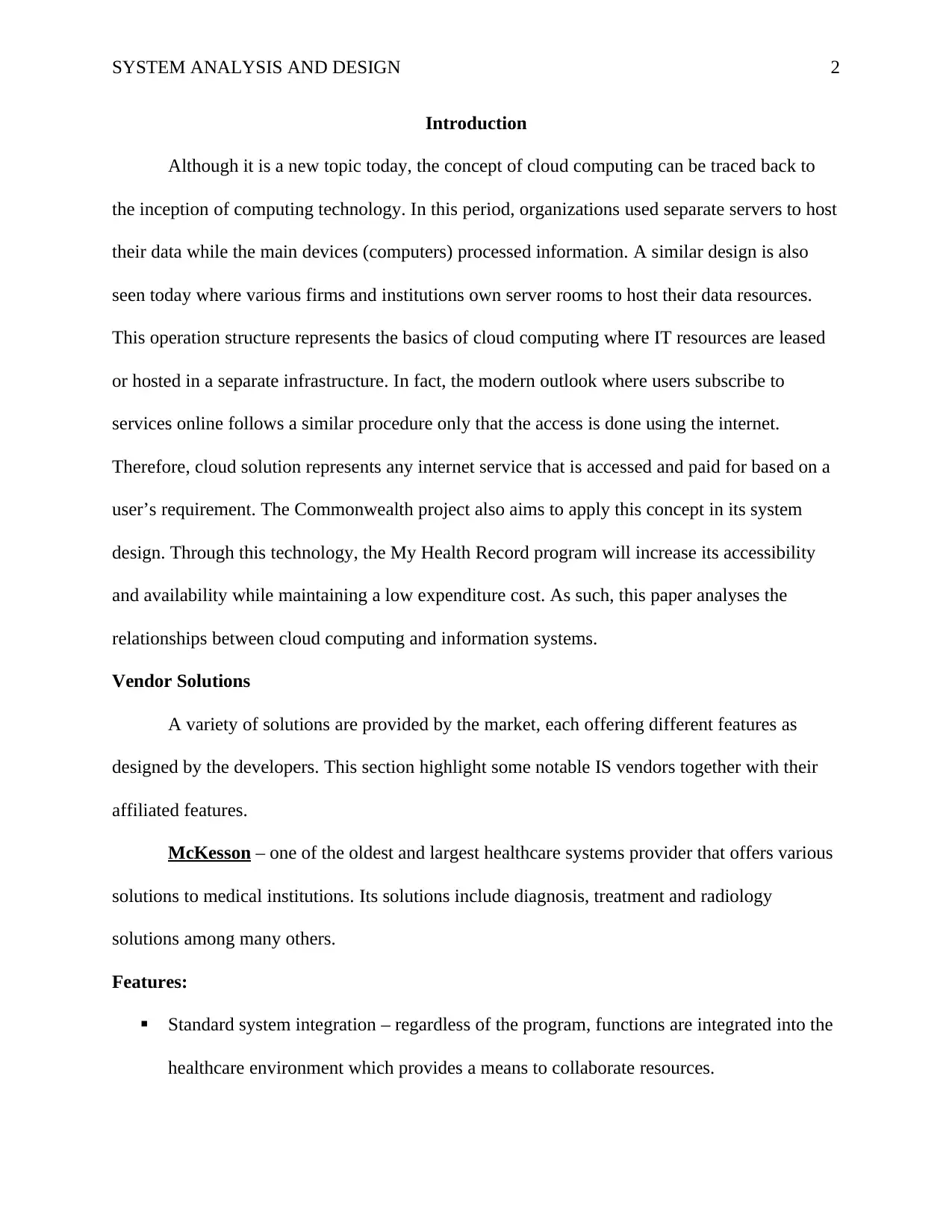
SYSTEM ANALYSIS AND DESIGN 2
Introduction
Although it is a new topic today, the concept of cloud computing can be traced back to
the inception of computing technology. In this period, organizations used separate servers to host
their data while the main devices (computers) processed information. A similar design is also
seen today where various firms and institutions own server rooms to host their data resources.
This operation structure represents the basics of cloud computing where IT resources are leased
or hosted in a separate infrastructure. In fact, the modern outlook where users subscribe to
services online follows a similar procedure only that the access is done using the internet.
Therefore, cloud solution represents any internet service that is accessed and paid for based on a
user’s requirement. The Commonwealth project also aims to apply this concept in its system
design. Through this technology, the My Health Record program will increase its accessibility
and availability while maintaining a low expenditure cost. As such, this paper analyses the
relationships between cloud computing and information systems.
Vendor Solutions
A variety of solutions are provided by the market, each offering different features as
designed by the developers. This section highlight some notable IS vendors together with their
affiliated features.
McKesson – one of the oldest and largest healthcare systems provider that offers various
solutions to medical institutions. Its solutions include diagnosis, treatment and radiology
solutions among many others.
Features:
Standard system integration – regardless of the program, functions are integrated into the
healthcare environment which provides a means to collaborate resources.
Introduction
Although it is a new topic today, the concept of cloud computing can be traced back to
the inception of computing technology. In this period, organizations used separate servers to host
their data while the main devices (computers) processed information. A similar design is also
seen today where various firms and institutions own server rooms to host their data resources.
This operation structure represents the basics of cloud computing where IT resources are leased
or hosted in a separate infrastructure. In fact, the modern outlook where users subscribe to
services online follows a similar procedure only that the access is done using the internet.
Therefore, cloud solution represents any internet service that is accessed and paid for based on a
user’s requirement. The Commonwealth project also aims to apply this concept in its system
design. Through this technology, the My Health Record program will increase its accessibility
and availability while maintaining a low expenditure cost. As such, this paper analyses the
relationships between cloud computing and information systems.
Vendor Solutions
A variety of solutions are provided by the market, each offering different features as
designed by the developers. This section highlight some notable IS vendors together with their
affiliated features.
McKesson – one of the oldest and largest healthcare systems provider that offers various
solutions to medical institutions. Its solutions include diagnosis, treatment and radiology
solutions among many others.
Features:
Standard system integration – regardless of the program, functions are integrated into the
healthcare environment which provides a means to collaborate resources.
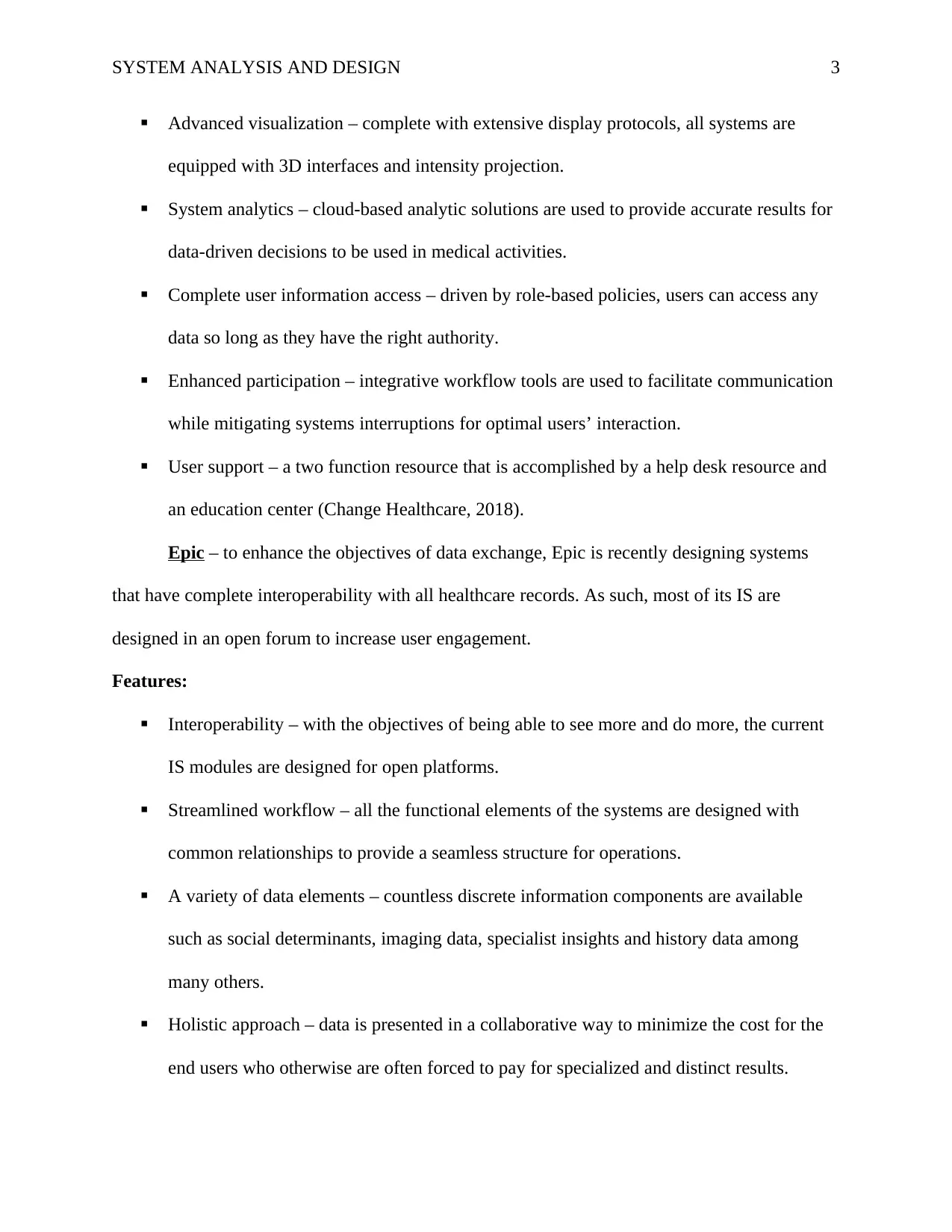
SYSTEM ANALYSIS AND DESIGN 3
Advanced visualization – complete with extensive display protocols, all systems are
equipped with 3D interfaces and intensity projection.
System analytics – cloud-based analytic solutions are used to provide accurate results for
data-driven decisions to be used in medical activities.
Complete user information access – driven by role-based policies, users can access any
data so long as they have the right authority.
Enhanced participation – integrative workflow tools are used to facilitate communication
while mitigating systems interruptions for optimal users’ interaction.
User support – a two function resource that is accomplished by a help desk resource and
an education center (Change Healthcare, 2018).
Epic – to enhance the objectives of data exchange, Epic is recently designing systems
that have complete interoperability with all healthcare records. As such, most of its IS are
designed in an open forum to increase user engagement.
Features:
Interoperability – with the objectives of being able to see more and do more, the current
IS modules are designed for open platforms.
Streamlined workflow – all the functional elements of the systems are designed with
common relationships to provide a seamless structure for operations.
A variety of data elements – countless discrete information components are available
such as social determinants, imaging data, specialist insights and history data among
many others.
Holistic approach – data is presented in a collaborative way to minimize the cost for the
end users who otherwise are often forced to pay for specialized and distinct results.
Advanced visualization – complete with extensive display protocols, all systems are
equipped with 3D interfaces and intensity projection.
System analytics – cloud-based analytic solutions are used to provide accurate results for
data-driven decisions to be used in medical activities.
Complete user information access – driven by role-based policies, users can access any
data so long as they have the right authority.
Enhanced participation – integrative workflow tools are used to facilitate communication
while mitigating systems interruptions for optimal users’ interaction.
User support – a two function resource that is accomplished by a help desk resource and
an education center (Change Healthcare, 2018).
Epic – to enhance the objectives of data exchange, Epic is recently designing systems
that have complete interoperability with all healthcare records. As such, most of its IS are
designed in an open forum to increase user engagement.
Features:
Interoperability – with the objectives of being able to see more and do more, the current
IS modules are designed for open platforms.
Streamlined workflow – all the functional elements of the systems are designed with
common relationships to provide a seamless structure for operations.
A variety of data elements – countless discrete information components are available
such as social determinants, imaging data, specialist insights and history data among
many others.
Holistic approach – data is presented in a collaborative way to minimize the cost for the
end users who otherwise are often forced to pay for specialized and distinct results.
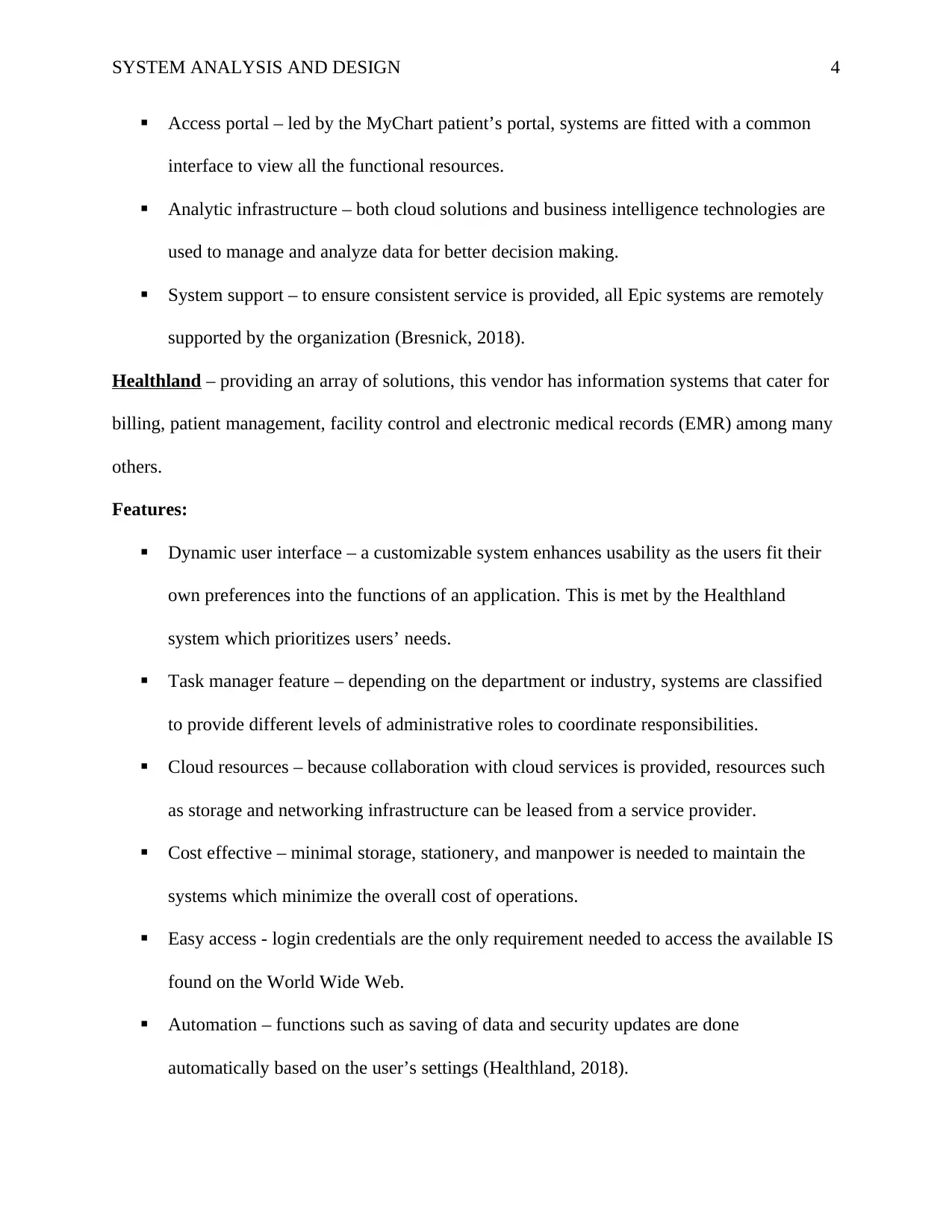
SYSTEM ANALYSIS AND DESIGN 4
Access portal – led by the MyChart patient’s portal, systems are fitted with a common
interface to view all the functional resources.
Analytic infrastructure – both cloud solutions and business intelligence technologies are
used to manage and analyze data for better decision making.
System support – to ensure consistent service is provided, all Epic systems are remotely
supported by the organization (Bresnick, 2018).
Healthland – providing an array of solutions, this vendor has information systems that cater for
billing, patient management, facility control and electronic medical records (EMR) among many
others.
Features:
Dynamic user interface – a customizable system enhances usability as the users fit their
own preferences into the functions of an application. This is met by the Healthland
system which prioritizes users’ needs.
Task manager feature – depending on the department or industry, systems are classified
to provide different levels of administrative roles to coordinate responsibilities.
Cloud resources – because collaboration with cloud services is provided, resources such
as storage and networking infrastructure can be leased from a service provider.
Cost effective – minimal storage, stationery, and manpower is needed to maintain the
systems which minimize the overall cost of operations.
Easy access - login credentials are the only requirement needed to access the available IS
found on the World Wide Web.
Automation – functions such as saving of data and security updates are done
automatically based on the user’s settings (Healthland, 2018).
Access portal – led by the MyChart patient’s portal, systems are fitted with a common
interface to view all the functional resources.
Analytic infrastructure – both cloud solutions and business intelligence technologies are
used to manage and analyze data for better decision making.
System support – to ensure consistent service is provided, all Epic systems are remotely
supported by the organization (Bresnick, 2018).
Healthland – providing an array of solutions, this vendor has information systems that cater for
billing, patient management, facility control and electronic medical records (EMR) among many
others.
Features:
Dynamic user interface – a customizable system enhances usability as the users fit their
own preferences into the functions of an application. This is met by the Healthland
system which prioritizes users’ needs.
Task manager feature – depending on the department or industry, systems are classified
to provide different levels of administrative roles to coordinate responsibilities.
Cloud resources – because collaboration with cloud services is provided, resources such
as storage and networking infrastructure can be leased from a service provider.
Cost effective – minimal storage, stationery, and manpower is needed to maintain the
systems which minimize the overall cost of operations.
Easy access - login credentials are the only requirement needed to access the available IS
found on the World Wide Web.
Automation – functions such as saving of data and security updates are done
automatically based on the user’s settings (Healthland, 2018).
Secure Best Marks with AI Grader
Need help grading? Try our AI Grader for instant feedback on your assignments.
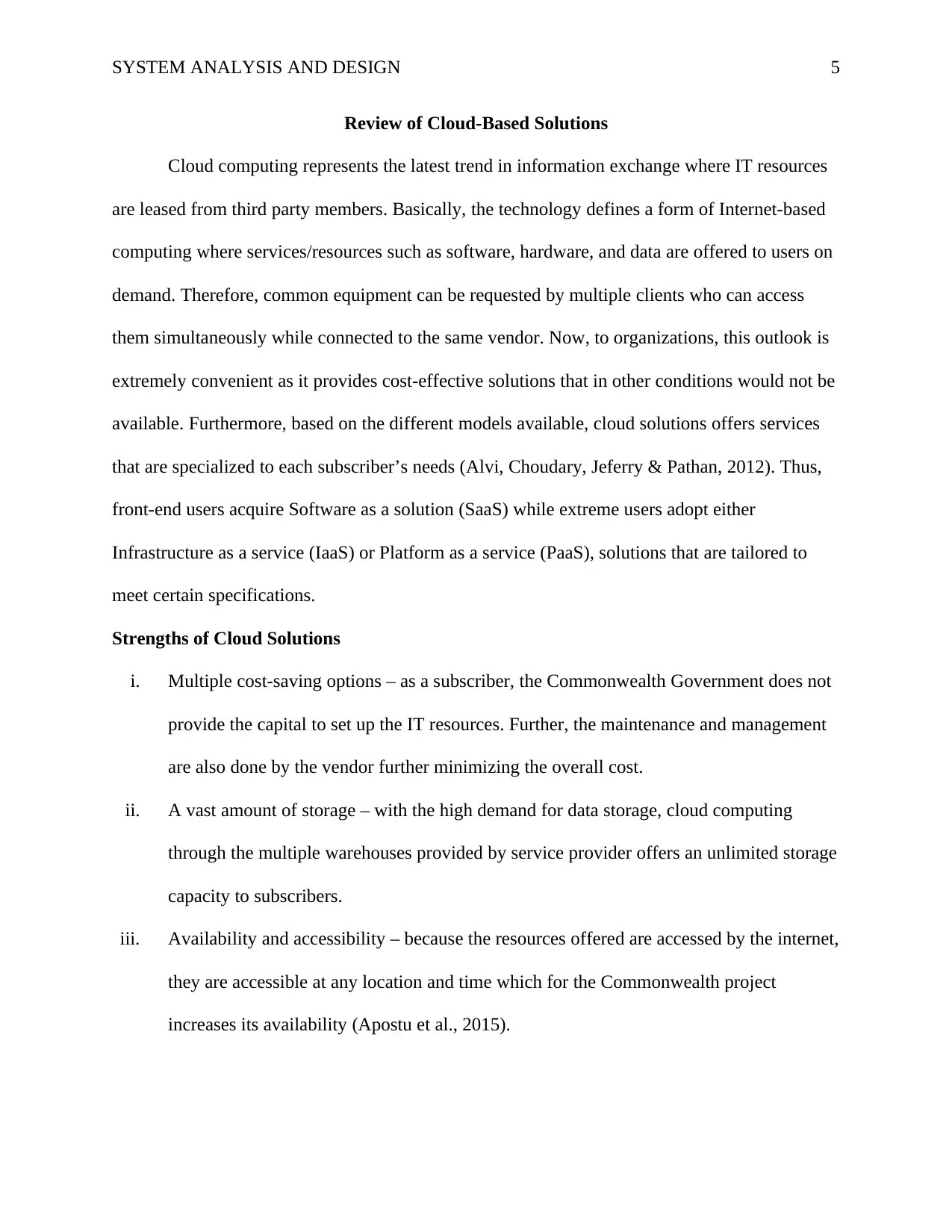
SYSTEM ANALYSIS AND DESIGN 5
Review of Cloud-Based Solutions
Cloud computing represents the latest trend in information exchange where IT resources
are leased from third party members. Basically, the technology defines a form of Internet-based
computing where services/resources such as software, hardware, and data are offered to users on
demand. Therefore, common equipment can be requested by multiple clients who can access
them simultaneously while connected to the same vendor. Now, to organizations, this outlook is
extremely convenient as it provides cost-effective solutions that in other conditions would not be
available. Furthermore, based on the different models available, cloud solutions offers services
that are specialized to each subscriber’s needs (Alvi, Choudary, Jeferry & Pathan, 2012). Thus,
front-end users acquire Software as a solution (SaaS) while extreme users adopt either
Infrastructure as a service (IaaS) or Platform as a service (PaaS), solutions that are tailored to
meet certain specifications.
Strengths of Cloud Solutions
i. Multiple cost-saving options – as a subscriber, the Commonwealth Government does not
provide the capital to set up the IT resources. Further, the maintenance and management
are also done by the vendor further minimizing the overall cost.
ii. A vast amount of storage – with the high demand for data storage, cloud computing
through the multiple warehouses provided by service provider offers an unlimited storage
capacity to subscribers.
iii. Availability and accessibility – because the resources offered are accessed by the internet,
they are accessible at any location and time which for the Commonwealth project
increases its availability (Apostu et al., 2015).
Review of Cloud-Based Solutions
Cloud computing represents the latest trend in information exchange where IT resources
are leased from third party members. Basically, the technology defines a form of Internet-based
computing where services/resources such as software, hardware, and data are offered to users on
demand. Therefore, common equipment can be requested by multiple clients who can access
them simultaneously while connected to the same vendor. Now, to organizations, this outlook is
extremely convenient as it provides cost-effective solutions that in other conditions would not be
available. Furthermore, based on the different models available, cloud solutions offers services
that are specialized to each subscriber’s needs (Alvi, Choudary, Jeferry & Pathan, 2012). Thus,
front-end users acquire Software as a solution (SaaS) while extreme users adopt either
Infrastructure as a service (IaaS) or Platform as a service (PaaS), solutions that are tailored to
meet certain specifications.
Strengths of Cloud Solutions
i. Multiple cost-saving options – as a subscriber, the Commonwealth Government does not
provide the capital to set up the IT resources. Further, the maintenance and management
are also done by the vendor further minimizing the overall cost.
ii. A vast amount of storage – with the high demand for data storage, cloud computing
through the multiple warehouses provided by service provider offers an unlimited storage
capacity to subscribers.
iii. Availability and accessibility – because the resources offered are accessed by the internet,
they are accessible at any location and time which for the Commonwealth project
increases its availability (Apostu et al., 2015).
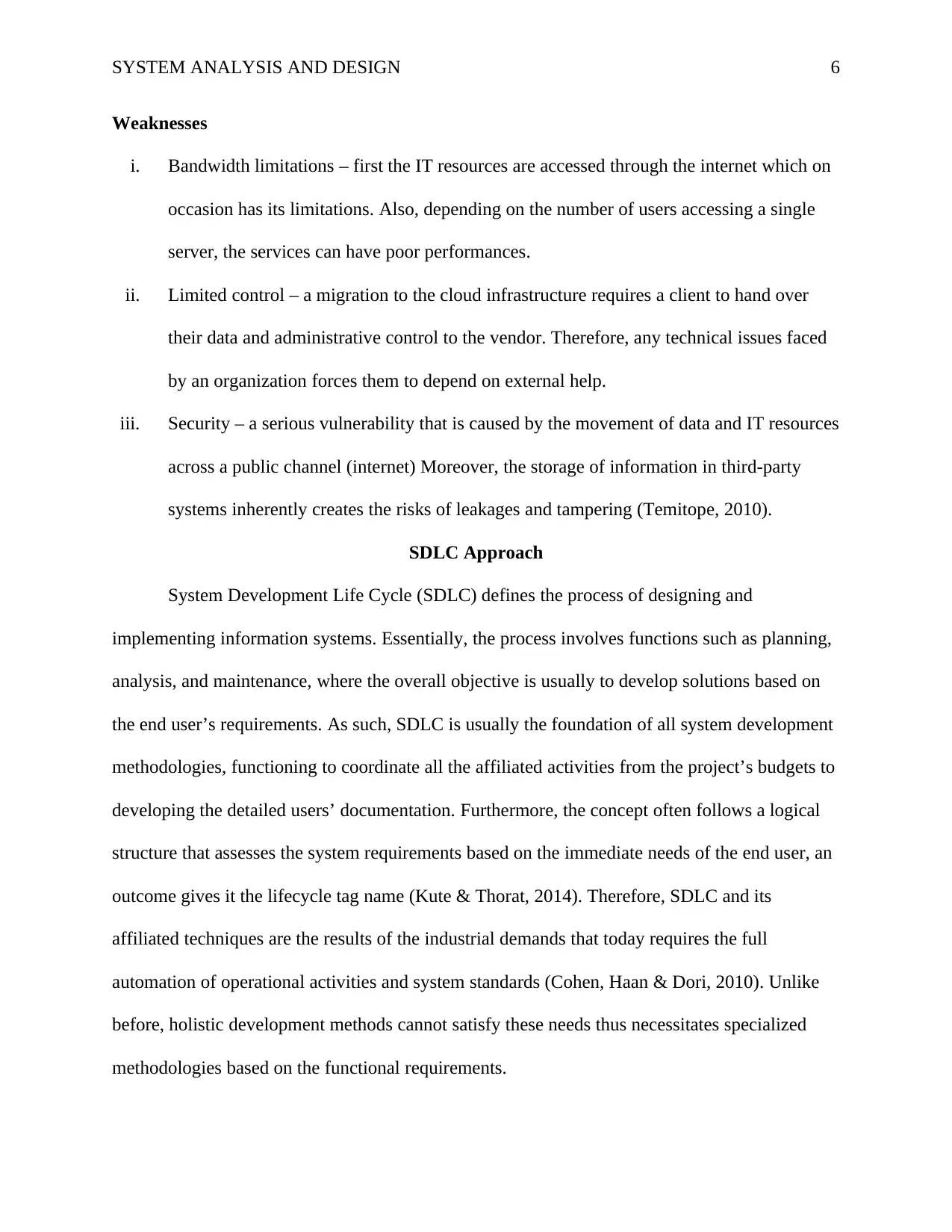
SYSTEM ANALYSIS AND DESIGN 6
Weaknesses
i. Bandwidth limitations – first the IT resources are accessed through the internet which on
occasion has its limitations. Also, depending on the number of users accessing a single
server, the services can have poor performances.
ii. Limited control – a migration to the cloud infrastructure requires a client to hand over
their data and administrative control to the vendor. Therefore, any technical issues faced
by an organization forces them to depend on external help.
iii. Security – a serious vulnerability that is caused by the movement of data and IT resources
across a public channel (internet) Moreover, the storage of information in third-party
systems inherently creates the risks of leakages and tampering (Temitope, 2010).
SDLC Approach
System Development Life Cycle (SDLC) defines the process of designing and
implementing information systems. Essentially, the process involves functions such as planning,
analysis, and maintenance, where the overall objective is usually to develop solutions based on
the end user’s requirements. As such, SDLC is usually the foundation of all system development
methodologies, functioning to coordinate all the affiliated activities from the project’s budgets to
developing the detailed users’ documentation. Furthermore, the concept often follows a logical
structure that assesses the system requirements based on the immediate needs of the end user, an
outcome gives it the lifecycle tag name (Kute & Thorat, 2014). Therefore, SDLC and its
affiliated techniques are the results of the industrial demands that today requires the full
automation of operational activities and system standards (Cohen, Haan & Dori, 2010). Unlike
before, holistic development methods cannot satisfy these needs thus necessitates specialized
methodologies based on the functional requirements.
Weaknesses
i. Bandwidth limitations – first the IT resources are accessed through the internet which on
occasion has its limitations. Also, depending on the number of users accessing a single
server, the services can have poor performances.
ii. Limited control – a migration to the cloud infrastructure requires a client to hand over
their data and administrative control to the vendor. Therefore, any technical issues faced
by an organization forces them to depend on external help.
iii. Security – a serious vulnerability that is caused by the movement of data and IT resources
across a public channel (internet) Moreover, the storage of information in third-party
systems inherently creates the risks of leakages and tampering (Temitope, 2010).
SDLC Approach
System Development Life Cycle (SDLC) defines the process of designing and
implementing information systems. Essentially, the process involves functions such as planning,
analysis, and maintenance, where the overall objective is usually to develop solutions based on
the end user’s requirements. As such, SDLC is usually the foundation of all system development
methodologies, functioning to coordinate all the affiliated activities from the project’s budgets to
developing the detailed users’ documentation. Furthermore, the concept often follows a logical
structure that assesses the system requirements based on the immediate needs of the end user, an
outcome gives it the lifecycle tag name (Kute & Thorat, 2014). Therefore, SDLC and its
affiliated techniques are the results of the industrial demands that today requires the full
automation of operational activities and system standards (Cohen, Haan & Dori, 2010). Unlike
before, holistic development methods cannot satisfy these needs thus necessitates specialized
methodologies based on the functional requirements.
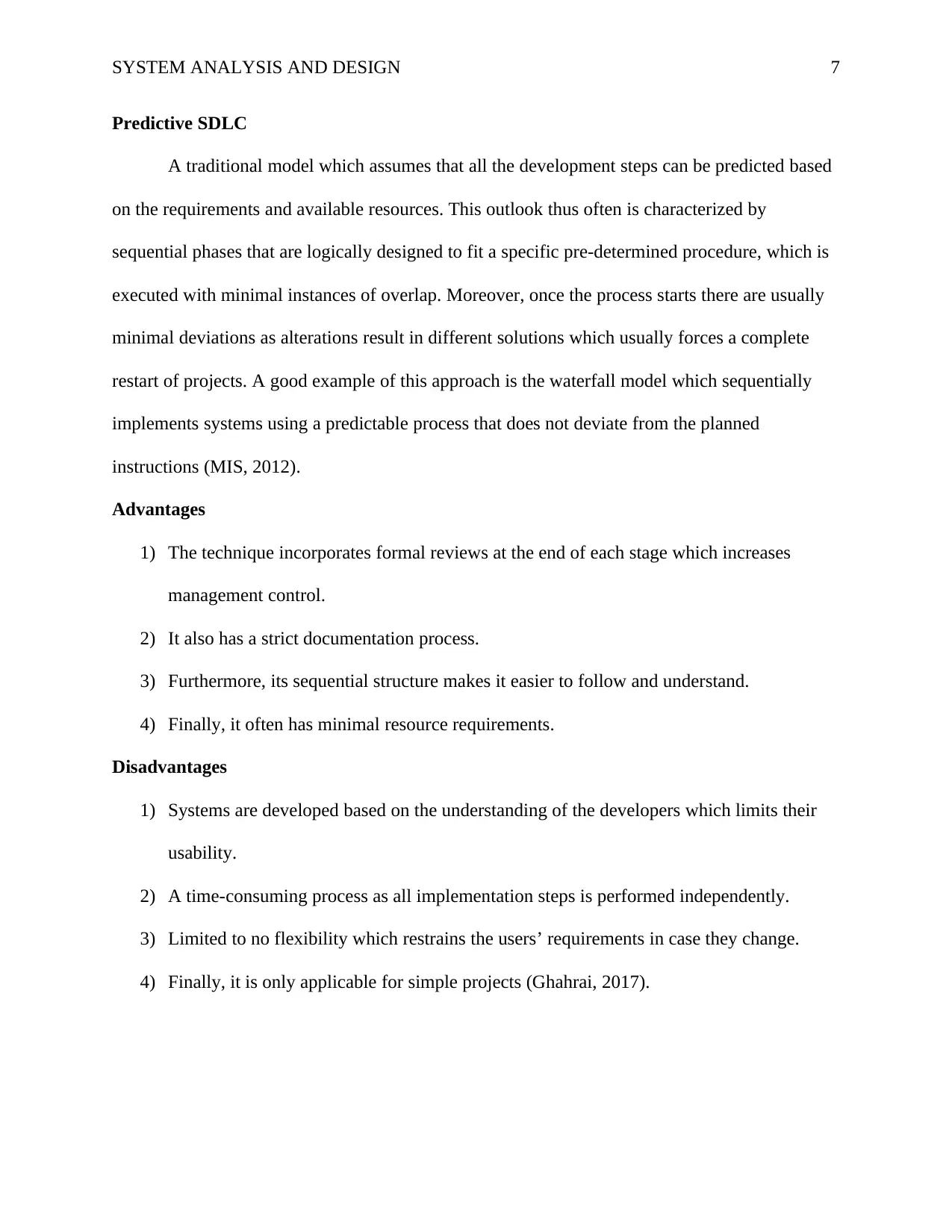
SYSTEM ANALYSIS AND DESIGN 7
Predictive SDLC
A traditional model which assumes that all the development steps can be predicted based
on the requirements and available resources. This outlook thus often is characterized by
sequential phases that are logically designed to fit a specific pre-determined procedure, which is
executed with minimal instances of overlap. Moreover, once the process starts there are usually
minimal deviations as alterations result in different solutions which usually forces a complete
restart of projects. A good example of this approach is the waterfall model which sequentially
implements systems using a predictable process that does not deviate from the planned
instructions (MIS, 2012).
Advantages
1) The technique incorporates formal reviews at the end of each stage which increases
management control.
2) It also has a strict documentation process.
3) Furthermore, its sequential structure makes it easier to follow and understand.
4) Finally, it often has minimal resource requirements.
Disadvantages
1) Systems are developed based on the understanding of the developers which limits their
usability.
2) A time-consuming process as all implementation steps is performed independently.
3) Limited to no flexibility which restrains the users’ requirements in case they change.
4) Finally, it is only applicable for simple projects (Ghahrai, 2017).
Predictive SDLC
A traditional model which assumes that all the development steps can be predicted based
on the requirements and available resources. This outlook thus often is characterized by
sequential phases that are logically designed to fit a specific pre-determined procedure, which is
executed with minimal instances of overlap. Moreover, once the process starts there are usually
minimal deviations as alterations result in different solutions which usually forces a complete
restart of projects. A good example of this approach is the waterfall model which sequentially
implements systems using a predictable process that does not deviate from the planned
instructions (MIS, 2012).
Advantages
1) The technique incorporates formal reviews at the end of each stage which increases
management control.
2) It also has a strict documentation process.
3) Furthermore, its sequential structure makes it easier to follow and understand.
4) Finally, it often has minimal resource requirements.
Disadvantages
1) Systems are developed based on the understanding of the developers which limits their
usability.
2) A time-consuming process as all implementation steps is performed independently.
3) Limited to no flexibility which restrains the users’ requirements in case they change.
4) Finally, it is only applicable for simple projects (Ghahrai, 2017).
Paraphrase This Document
Need a fresh take? Get an instant paraphrase of this document with our AI Paraphraser
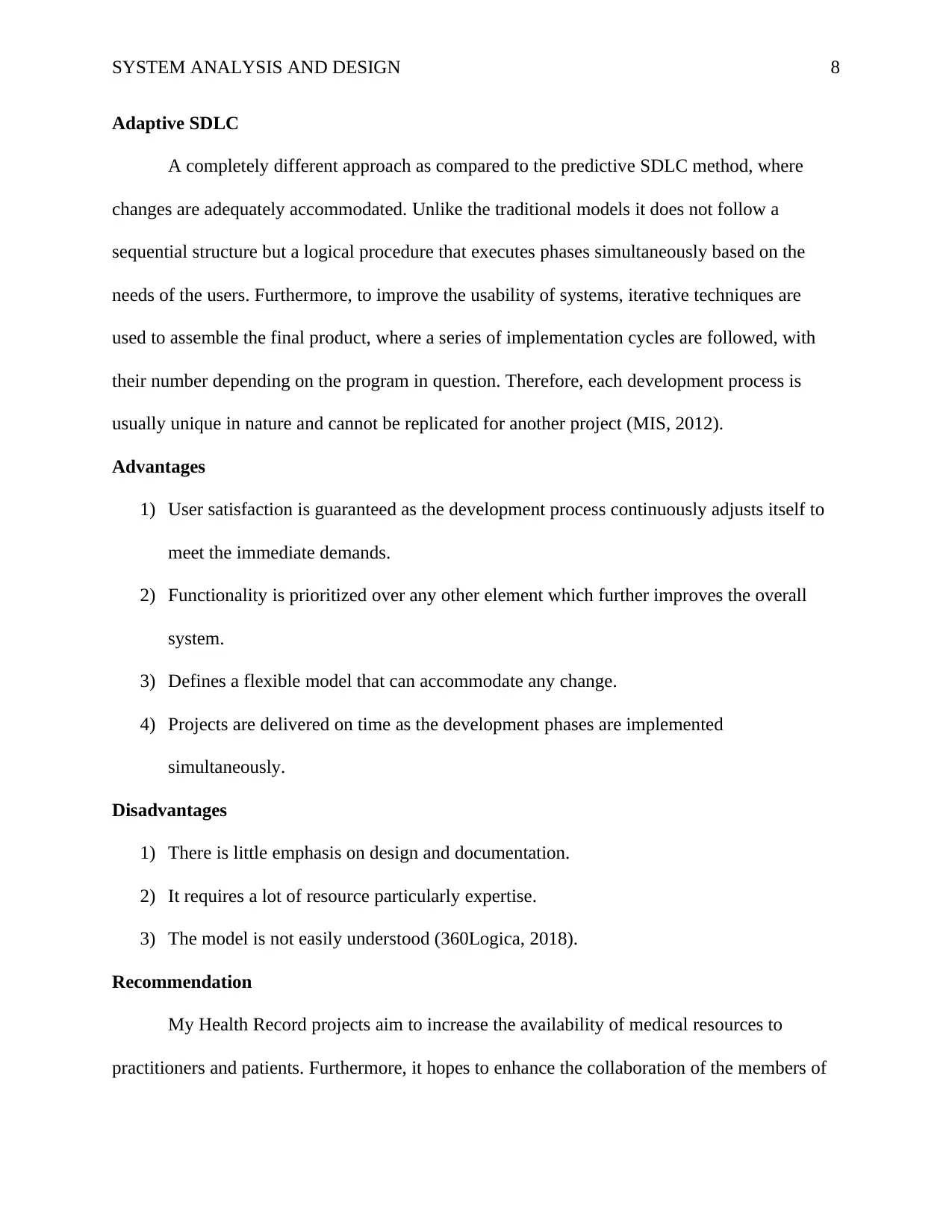
SYSTEM ANALYSIS AND DESIGN 8
Adaptive SDLC
A completely different approach as compared to the predictive SDLC method, where
changes are adequately accommodated. Unlike the traditional models it does not follow a
sequential structure but a logical procedure that executes phases simultaneously based on the
needs of the users. Furthermore, to improve the usability of systems, iterative techniques are
used to assemble the final product, where a series of implementation cycles are followed, with
their number depending on the program in question. Therefore, each development process is
usually unique in nature and cannot be replicated for another project (MIS, 2012).
Advantages
1) User satisfaction is guaranteed as the development process continuously adjusts itself to
meet the immediate demands.
2) Functionality is prioritized over any other element which further improves the overall
system.
3) Defines a flexible model that can accommodate any change.
4) Projects are delivered on time as the development phases are implemented
simultaneously.
Disadvantages
1) There is little emphasis on design and documentation.
2) It requires a lot of resource particularly expertise.
3) The model is not easily understood (360Logica, 2018).
Recommendation
My Health Record projects aim to increase the availability of medical resources to
practitioners and patients. Furthermore, it hopes to enhance the collaboration of the members of
Adaptive SDLC
A completely different approach as compared to the predictive SDLC method, where
changes are adequately accommodated. Unlike the traditional models it does not follow a
sequential structure but a logical procedure that executes phases simultaneously based on the
needs of the users. Furthermore, to improve the usability of systems, iterative techniques are
used to assemble the final product, where a series of implementation cycles are followed, with
their number depending on the program in question. Therefore, each development process is
usually unique in nature and cannot be replicated for another project (MIS, 2012).
Advantages
1) User satisfaction is guaranteed as the development process continuously adjusts itself to
meet the immediate demands.
2) Functionality is prioritized over any other element which further improves the overall
system.
3) Defines a flexible model that can accommodate any change.
4) Projects are delivered on time as the development phases are implemented
simultaneously.
Disadvantages
1) There is little emphasis on design and documentation.
2) It requires a lot of resource particularly expertise.
3) The model is not easily understood (360Logica, 2018).
Recommendation
My Health Record projects aim to increase the availability of medical resources to
practitioners and patients. Furthermore, it hopes to enhance the collaboration of the members of
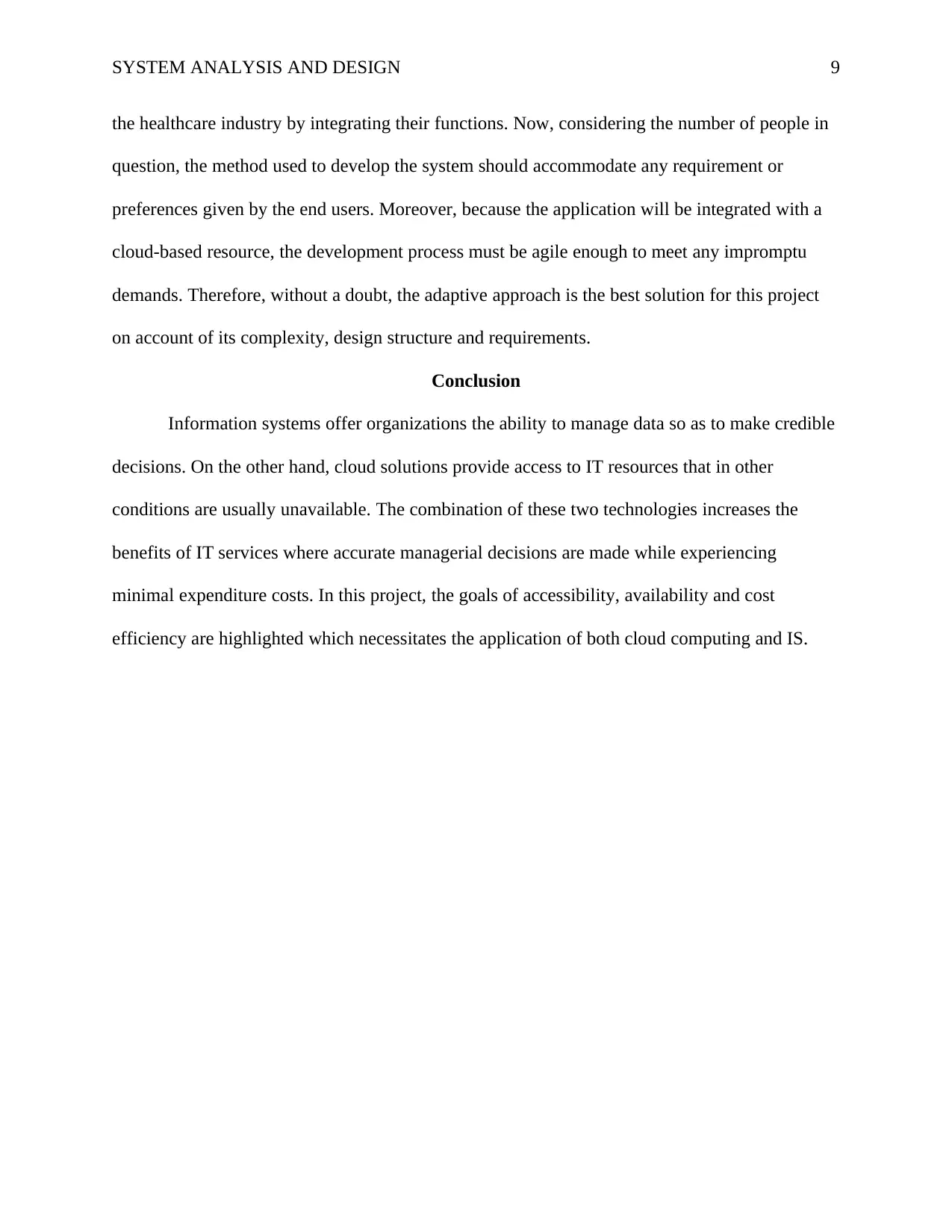
SYSTEM ANALYSIS AND DESIGN 9
the healthcare industry by integrating their functions. Now, considering the number of people in
question, the method used to develop the system should accommodate any requirement or
preferences given by the end users. Moreover, because the application will be integrated with a
cloud-based resource, the development process must be agile enough to meet any impromptu
demands. Therefore, without a doubt, the adaptive approach is the best solution for this project
on account of its complexity, design structure and requirements.
Conclusion
Information systems offer organizations the ability to manage data so as to make credible
decisions. On the other hand, cloud solutions provide access to IT resources that in other
conditions are usually unavailable. The combination of these two technologies increases the
benefits of IT services where accurate managerial decisions are made while experiencing
minimal expenditure costs. In this project, the goals of accessibility, availability and cost
efficiency are highlighted which necessitates the application of both cloud computing and IS.
the healthcare industry by integrating their functions. Now, considering the number of people in
question, the method used to develop the system should accommodate any requirement or
preferences given by the end users. Moreover, because the application will be integrated with a
cloud-based resource, the development process must be agile enough to meet any impromptu
demands. Therefore, without a doubt, the adaptive approach is the best solution for this project
on account of its complexity, design structure and requirements.
Conclusion
Information systems offer organizations the ability to manage data so as to make credible
decisions. On the other hand, cloud solutions provide access to IT resources that in other
conditions are usually unavailable. The combination of these two technologies increases the
benefits of IT services where accurate managerial decisions are made while experiencing
minimal expenditure costs. In this project, the goals of accessibility, availability and cost
efficiency are highlighted which necessitates the application of both cloud computing and IS.
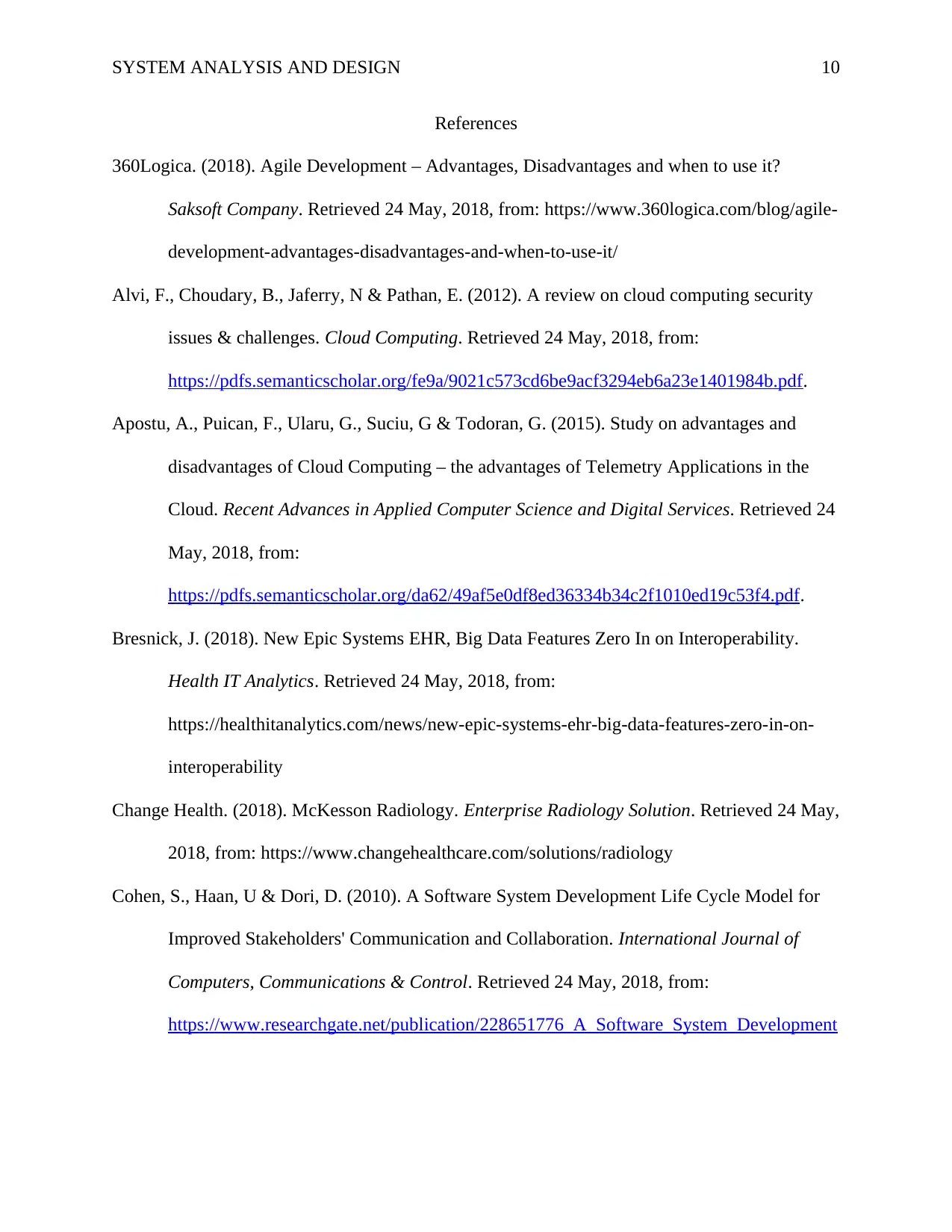
SYSTEM ANALYSIS AND DESIGN 10
References
360Logica. (2018). Agile Development – Advantages, Disadvantages and when to use it?
Saksoft Company. Retrieved 24 May, 2018, from: https://www.360logica.com/blog/agile-
development-advantages-disadvantages-and-when-to-use-it/
Alvi, F., Choudary, B., Jaferry, N & Pathan, E. (2012). A review on cloud computing security
issues & challenges. Cloud Computing. Retrieved 24 May, 2018, from:
https://pdfs.semanticscholar.org/fe9a/9021c573cd6be9acf3294eb6a23e1401984b.pdf.
Apostu, A., Puican, F., Ularu, G., Suciu, G & Todoran, G. (2015). Study on advantages and
disadvantages of Cloud Computing – the advantages of Telemetry Applications in the
Cloud. Recent Advances in Applied Computer Science and Digital Services. Retrieved 24
May, 2018, from:
https://pdfs.semanticscholar.org/da62/49af5e0df8ed36334b34c2f1010ed19c53f4.pdf.
Bresnick, J. (2018). New Epic Systems EHR, Big Data Features Zero In on Interoperability.
Health IT Analytics. Retrieved 24 May, 2018, from:
https://healthitanalytics.com/news/new-epic-systems-ehr-big-data-features-zero-in-on-
interoperability
Change Health. (2018). McKesson Radiology. Enterprise Radiology Solution. Retrieved 24 May,
2018, from: https://www.changehealthcare.com/solutions/radiology
Cohen, S., Haan, U & Dori, D. (2010). A Software System Development Life Cycle Model for
Improved Stakeholders' Communication and Collaboration. International Journal of
Computers, Communications & Control. Retrieved 24 May, 2018, from:
https://www.researchgate.net/publication/228651776_A_Software_System_Development
References
360Logica. (2018). Agile Development – Advantages, Disadvantages and when to use it?
Saksoft Company. Retrieved 24 May, 2018, from: https://www.360logica.com/blog/agile-
development-advantages-disadvantages-and-when-to-use-it/
Alvi, F., Choudary, B., Jaferry, N & Pathan, E. (2012). A review on cloud computing security
issues & challenges. Cloud Computing. Retrieved 24 May, 2018, from:
https://pdfs.semanticscholar.org/fe9a/9021c573cd6be9acf3294eb6a23e1401984b.pdf.
Apostu, A., Puican, F., Ularu, G., Suciu, G & Todoran, G. (2015). Study on advantages and
disadvantages of Cloud Computing – the advantages of Telemetry Applications in the
Cloud. Recent Advances in Applied Computer Science and Digital Services. Retrieved 24
May, 2018, from:
https://pdfs.semanticscholar.org/da62/49af5e0df8ed36334b34c2f1010ed19c53f4.pdf.
Bresnick, J. (2018). New Epic Systems EHR, Big Data Features Zero In on Interoperability.
Health IT Analytics. Retrieved 24 May, 2018, from:
https://healthitanalytics.com/news/new-epic-systems-ehr-big-data-features-zero-in-on-
interoperability
Change Health. (2018). McKesson Radiology. Enterprise Radiology Solution. Retrieved 24 May,
2018, from: https://www.changehealthcare.com/solutions/radiology
Cohen, S., Haan, U & Dori, D. (2010). A Software System Development Life Cycle Model for
Improved Stakeholders' Communication and Collaboration. International Journal of
Computers, Communications & Control. Retrieved 24 May, 2018, from:
https://www.researchgate.net/publication/228651776_A_Software_System_Development
Secure Best Marks with AI Grader
Need help grading? Try our AI Grader for instant feedback on your assignments.
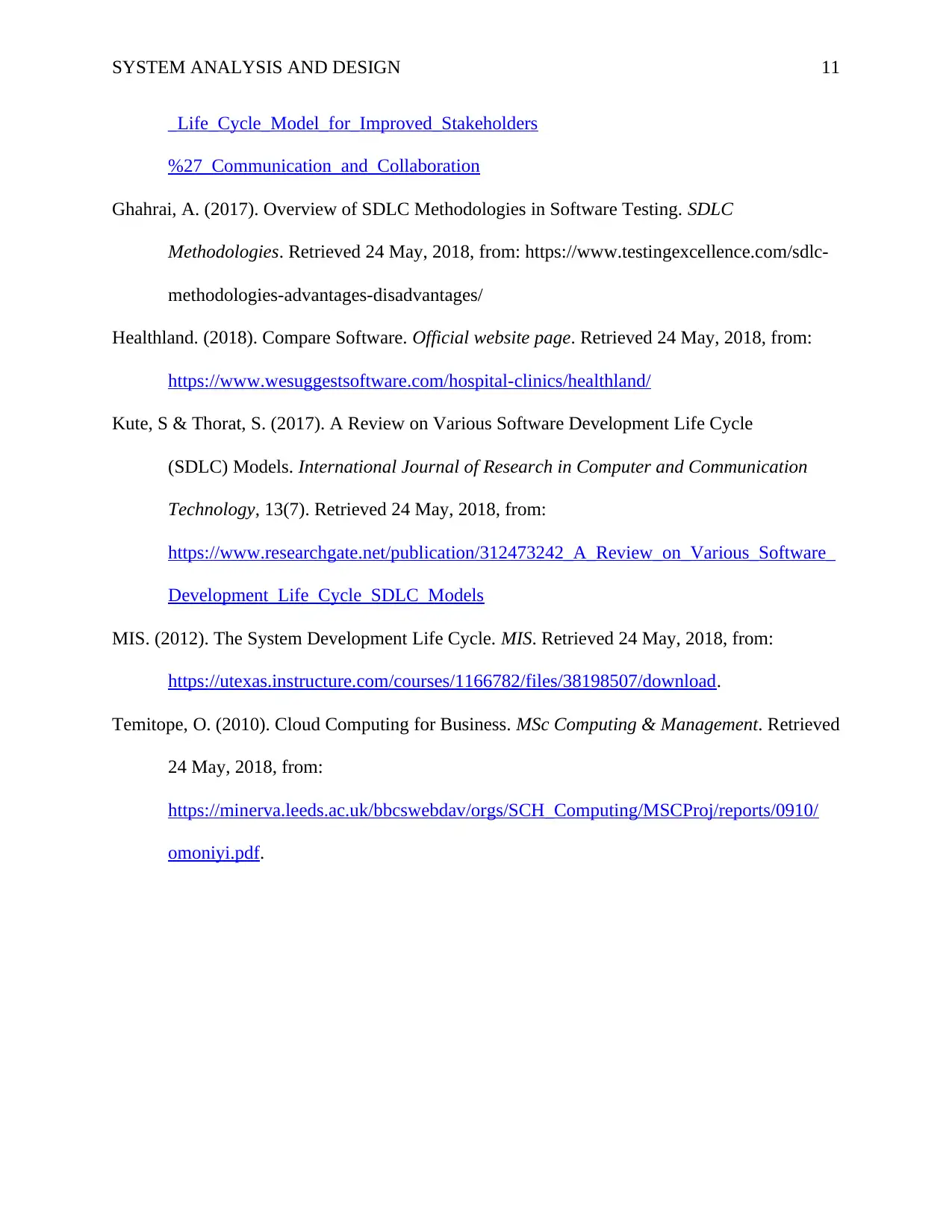
SYSTEM ANALYSIS AND DESIGN 11
_Life_Cycle_Model_for_Improved_Stakeholders
%27_Communication_and_Collaboration
Ghahrai, A. (2017). Overview of SDLC Methodologies in Software Testing. SDLC
Methodologies. Retrieved 24 May, 2018, from: https://www.testingexcellence.com/sdlc-
methodologies-advantages-disadvantages/
Healthland. (2018). Compare Software. Official website page. Retrieved 24 May, 2018, from:
https://www.wesuggestsoftware.com/hospital-clinics/healthland/
Kute, S & Thorat, S. (2017). A Review on Various Software Development Life Cycle
(SDLC) Models. International Journal of Research in Computer and Communication
Technology, 13(7). Retrieved 24 May, 2018, from:
https://www.researchgate.net/publication/312473242_A_Review_on_Various_Software_
Development_Life_Cycle_SDLC_Models
MIS. (2012). The System Development Life Cycle. MIS. Retrieved 24 May, 2018, from:
https://utexas.instructure.com/courses/1166782/files/38198507/download.
Temitope, O. (2010). Cloud Computing for Business. MSc Computing & Management. Retrieved
24 May, 2018, from:
https://minerva.leeds.ac.uk/bbcswebdav/orgs/SCH_Computing/MSCProj/reports/0910/
omoniyi.pdf.
_Life_Cycle_Model_for_Improved_Stakeholders
%27_Communication_and_Collaboration
Ghahrai, A. (2017). Overview of SDLC Methodologies in Software Testing. SDLC
Methodologies. Retrieved 24 May, 2018, from: https://www.testingexcellence.com/sdlc-
methodologies-advantages-disadvantages/
Healthland. (2018). Compare Software. Official website page. Retrieved 24 May, 2018, from:
https://www.wesuggestsoftware.com/hospital-clinics/healthland/
Kute, S & Thorat, S. (2017). A Review on Various Software Development Life Cycle
(SDLC) Models. International Journal of Research in Computer and Communication
Technology, 13(7). Retrieved 24 May, 2018, from:
https://www.researchgate.net/publication/312473242_A_Review_on_Various_Software_
Development_Life_Cycle_SDLC_Models
MIS. (2012). The System Development Life Cycle. MIS. Retrieved 24 May, 2018, from:
https://utexas.instructure.com/courses/1166782/files/38198507/download.
Temitope, O. (2010). Cloud Computing for Business. MSc Computing & Management. Retrieved
24 May, 2018, from:
https://minerva.leeds.ac.uk/bbcswebdav/orgs/SCH_Computing/MSCProj/reports/0910/
omoniyi.pdf.
1 out of 11
Related Documents
Your All-in-One AI-Powered Toolkit for Academic Success.
+13062052269
info@desklib.com
Available 24*7 on WhatsApp / Email
![[object Object]](/_next/static/media/star-bottom.7253800d.svg)
Unlock your academic potential
© 2024 | Zucol Services PVT LTD | All rights reserved.





